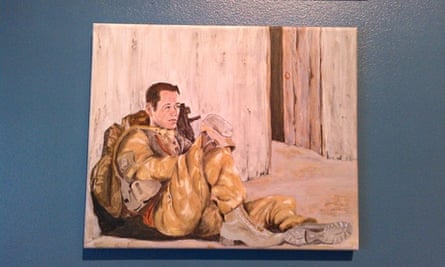The brown paper parcel the postman delivered two weeks ago to Kim Sweeney's home in Blyth, Northumberland, looked boring and nondescript. As she ripped at the paper, she noticed there was no return address, no signature. The postmark was unidentifiable.
Then, inside the layers of packaging, she discovered a portrait of her son, Michael, who was 19 years old when he was killed in Helmand Province, Afghanistan, while on patrol with the 1st Battalion Coldstream Guards in 2010.
Tucked in with the portrait was a torn scrap of paper with a scribbled message. The painter had seen a photograph of Michael in a newspaper, the note explained, and it moved them to paint his portrait. The mystery artist hoped Sweeney and her husband would not be offended and that they would keep the painting as a sign of condolence. At the bottom was a small signature that looked like it could read "Pam G".
Sweeney was at a loss: she was holding the "exact likeness" of her son, but had no idea who to thank for it. "The look on his face is so sad," she told the Guardian. "Every single time I look at the painting I get a lump in my throat. I can't help wondering what he was thinking of when that photo was taken. I hope it was home."

The enigmatic portrait was based on a picture taken by AJ Heath, a photographer who spent a week embedded with Michael's company in Afghanistan in March 2010. "He was always acting up to the camera," said Heath, when told about the painting. "I know his mother thinks he looks sad, [but] he was actually posing the usual 1,000-yard stare and knew full well I was taking the photograph."
Artists choosing anonymity over praise when documenting war has been intriguingly common throughout history, right through to this odd case in Northumberland's suburbs. Why do artists, who produce work to be consumed and appreciated by others, so often waive acknowledgment when painting or photographing war? Does anonymity free them from any association with either side of a conflict? Does the mystery lend more gravitas? And how many masters in the making have been lost in the mess of history and time?
One of the most famous anonymous war paintings is the National Gallery's A Dead Soldier, attributed to "An Italian". Examinations since it was bought in 1865 have determined only that it is of Italian, perhaps Neapolitan, origin, and painted in the 1630s; nothing more. A small monogrammed "A", uncovered in 1945, could indicate that the artist wanted to own their work originally, but the smudged letter sheds no light on their true identity.
As art reveals the artist, so creative energies often shift underground in times of conflict. French artists worked anonymously during the German occupation because of the Nazis' hatred of "degenerate" styles, as did Nazi-opposing German artists, who sought to disguise their work from both their contemporaries and their countrymen. In apartheid South Africa in the 1980s, anonymity enabled resistance; white-middle class artists produced unattributed work to explain the common cause, while activists displayed images of state violence at traffic intersections to educate and shock the public.
Imagine if all art was anonymous. Suddenly pieces would be open to wider interpretation, free from consumers' assumptions or prejudices about the artist's class and ethnicity. Does knowing more about the creator reveal more about their work, or is mystery more intriguing than any understanding?
Back at the Sweeneys', the stance on unknown artists is clear. The painting of Michael has pride of place in the dining room, and his mother has turned to Facebook to hunt for the mystery painter, but has had no success in revealing any further clues as to who "Pam G" might be, or where they might live.
"I understand if [Pam G] doesn't want to be contacted, but I really want them to know that the painting was well received and I am very thankful for it," Sweeney told the Guardian. "Though it makes me cry, it was a lovely thing to do."

Comments (…)
Sign in or create your Guardian account to join the discussion